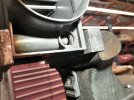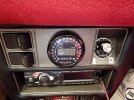Ron Avery
True Classic
As some of you may know, my Montecarlo as been in the shop since last July. On my way from Oxnard Ca. To the Lancia event up north, I discovered that the car was running very lean. I made it up to The Monterey are. And had to turn around and go home. The engine temp did not reflect how hot the exhaust system had become ( the temp gauge was normal). When we got up to Monterey, I discovered that the paint on my rear bumper had blistered. I checked the plugs and they looked white. As most of you may know my Montecarlo has 2.0 with Bosch L jet injection, had been running good for years. Even before I purchased the car in 2022. The FI system does not allow much if not any adjustability. When I arrived home I took the car to my shop. They had an exhaust analyzer read the air fuel ratio. It was very lean, and confirmed my suspicions. They were quite busy so it sat for a while. We looked over the exhaust system after I pulled the bumper for a repaint. It turns out that two of the header tube had cracked near the flange. And the exhaust pipes on either end of the muffler had also cracked. I had the header re welded and head coated. The rest of the exhaust system was also repaired. We then set about replacing a lot of the fuel supply system. New injectors, new coolant temp sensor, new fuel filter, new fuel pressure regulator. We checked the Mass airflow meter ,It was not dirty and the flap moved freely. We also replaced the wiring harness to the mass airflow meter .We did find that the rubber air intake hose for the Mass air flow meter, had deteriorated, and had some cracks. So a suitable replacement part.was found. I also replaced.the thermostat. I also had the color start valve replaced. The photo of the spark plug is from after the repair work.

 We did burp the cooling system, we then ran the car, it was still lean, not has lean. But more than we liked. The ignition timing was checked and found to be at spec.
We did burp the cooling system, we then ran the car, it was still lean, not has lean. But more than we liked. The ignition timing was checked and found to be at spec.
My shop then drilled out the plug in the Mass Aiflow meter to adjust the air intake screw. As per the Bosch shop manual. This did the trick. The next visit to the Analyzer showed we were within spec with the reading..We also performed a leak down test on the engine, to see if it had any damage . It was well within Normal parameters . What a relief! I forgot to mention that we did add heat, shielding material above the exhaust system, and on the backside of the bumper.








My shop then drilled out the plug in the Mass Aiflow meter to adjust the air intake screw. As per the Bosch shop manual. This did the trick. The next visit to the Analyzer showed we were within spec with the reading..We also performed a leak down test on the engine, to see if it had any damage . It was well within Normal parameters . What a relief! I forgot to mention that we did add heat, shielding material above the exhaust system, and on the backside of the bumper.

Last edited:

